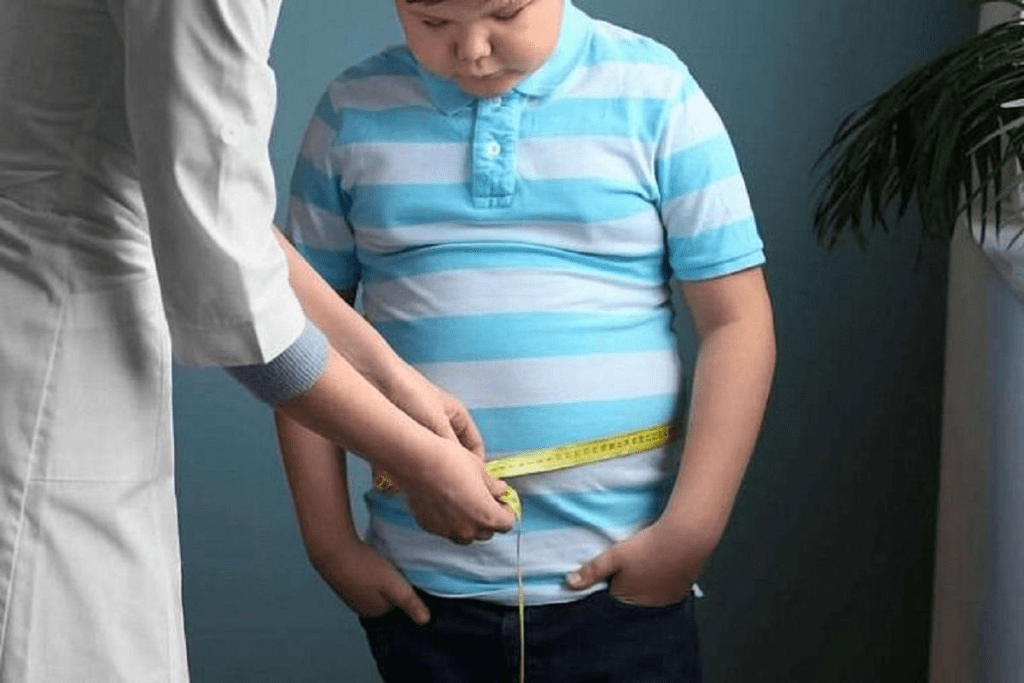Last Updated on November 14, 2025 by

Childhood obesity is a big problem worldwide. It has serious effects on health now and in the future. It’s a major issue for our kids and our communities.
The biggest reason for childhood obesity is when we eat more calories than we burn. The World Health Organization (WHO) says over 390 million kids and teens aged 5-19 were overweight in 2022. This shows we really need to know why kids get overweight.
We must understand why kids get overweight to help them stay healthy. By knowing the reasons, we can make better plans to prevent and treat obesity in kids.
Childhood obesity is a growing problem worldwide. It affects not just the child but also society as a whole.
The World Health Organization (WHO) says that more kids are overweight or obese. From 8% in 1990 to 20% in 2022, about 390 million children are now affected.
Childhood obesity leads to serious health issues. Kids who are obese are at higher risk for type 2 diabetes, high blood pressure, and heart disease.
“Obesity is a major risk factor for non-communicable diseases.”
World Health Organization
This highlights the importance of acting early to prevent these problems.

It’s key to know what causes childhood obesity. Things like lifestyle habits in kids, dietary patterns in children, and screen time impact on kids are important.
Childhood obesity is a complex issue. At its core is the issue of caloric imbalance. This happens when we eat more calories than we burn. Factors like what we eat and how active we are play a big role.
Energy balance is key for kids to grow healthily. It’s about the calories we get from food and drinks versus the calories we use. Research shows that just 30 extra kilocalories a day can lead to obesity in kids. This shows how delicate energy balance is.
“A child’s energy balance is influenced by multiple factors, including their diet, physical activity levels, and overall lifestyle.” It’s important for kids to eat well and stay active. This helps them keep a healthy weight.
Diets high in calories but low in nutrients are a big problem. Foods and drinks high in sugar and unhealthy fats give too many calories. They don’t give the nutrients kids need to grow.
Parents have a big role in shaping their kids’ eating habits. Parental influence on obesity is significant. Kids often copy what their parents eat. Healthy eating habits and balanced meals can help prevent obesity.
Many kids are less active today. This is partly because of more screen time. Being less active means they burn fewer calories.
It’s important to encourage kids to be active. Activities like sports, dancing, or playing outside can help. They increase activity levels and help with energy balance.
Too much screen time and sitting around can lead to obesity in kids. It reduces physical activity and often goes with unhealthy snacking.
“The way we live, including our socio-economic factors, influences our risk of obesity. Understanding these factors can help in developing targeted interventions.”
To tackle caloric imbalance, we need a broad approach. We should promote healthy eating, more activity, and less sitting. By understanding what causes childhood obesity, we can make a better environment for kids to grow.

The family environment is key in shaping a child’s eating habits and lifestyle. It’s where healthy or unhealthy habits are formed. This is a critical setting for a child’s development.
Parents have a big impact on their children’s eating habits. Research shows that “children learn eating habits by observing their parents’ behaviour”. When parents eat healthily, kids are more likely to do the same.
Mealtime in the family can shape a child’s diet. Regular meals help kids develop good eating habits. But irregular or rushed meals can lead to bad choices.
As “family meals provide an opportunity to model and reinforce healthy eating behaviours”, making mealtime positive is key.
The food available at home affects a child’s eating habits. Unhealthy snacks can lead to too many calories. But having fruits and veggies around encourages healthy eating.
Having healthy snacks around helps kids make better choices. It’s also important to watch portion sizes to avoid overeating. As “snacking is a common behaviour among children”, parents should choose wisely.
Having a regular mealtime routine helps kids feel secure and develop good eating habits. This includes not using screens during meals and talking more.
Understanding these five factors helps parents create a healthier home. This promotes positive eating habits and lifestyle choices for their kids.
Socioeconomic factors greatly affect the risk of childhood obesity. They influence diet and physical activity levels. Children from lower socioeconomic backgrounds are more likely to be obese due to various factors.
Income disparity is a key factor in childhood obesity. Low-income families often eat high-calorie, high-fat foods because they are cheaper. “A family’s income level can significantly influence the quality of their diet.” Communities with few supermarkets and many fast-food places have higher obesity rates.
Neighbourhood safety is also important. Children in unsafe areas are less likely to play outside. “Parents’ concerns about safety can limit children’s opportunities for exercise.” This can make them more likely to gain weight and become obese.
Having access to education and health literacy is key. Families that understand health better can make better choices. Programs that teach about healthy eating and exercise are very helpful.
Schools are important in shaping kids’ eating habits. Schools that offer healthy meals and promote good eating can help prevent obesity.
“Schools are a critical environment for promoting healthy behaviors among children.”
Community support is vital. Programs like after-school activities and recreational facilities are essential. They provide kids with chances to be active and social, helping fight obesity. By supporting families and kids, communities can lower obesity risks.
It’s key to know how childhood obesity is linked to biology and genes. Diet and exercise are important, but genetics and biology also matter a lot. They help decide if a child might get obese.
Studies show genes can make some people more likely to gain weight. Some genes affect hunger, metabolism, and fat storage. This makes it hard for kids to stay at a healthy weight. But it’s not just genes; what’s around us also matters a lot.
How well a child sleeps is very important for their weight. Bad sleep can mess with hormones, making kids hungrier and eat more. This can lead to gaining weight.
What happens early in life can shape a child’s metabolism and obesity risk. This includes what the mom eats during pregnancy and how the baby is fed.
What the mom eats and her health during pregnancy matter a lot. It affects the baby’s metabolism and health later on. Things like the mom’s diet and weight gain can influence this.
How a baby is fed, such as through breastfeeding, is also very important. Breastfeeding is linked to lower obesity risk later on.
Knowing about these factors helps us find ways to help kids at risk of obesity. We can work on making their health better.
Preventing childhood obesity needs a full plan that tackles many issues. We’ve looked at things like too many calories, family settings, money matters, and body traits. These all play a part in a child’s weight.
The World Health Organization suggests a few key steps. They say we should encourage good eating, moving more, and less sitting. Knowing what affects a child’s weight helps us teach them healthy habits.
Our study shows it’s key to tackle the main reasons for childhood obesity. This includes bad diets and less exercise for kids. If we all work together, we can make sure kids grow up healthy. This will help them have a better future.
The main cause of childhood obesity is eating too many calories and not enough nutrients. This happens when kids eat foods high in calories but low in nutrients. At the same time, they do less physical activity.
Parents’ eating habits greatly affect their kids’ diet and lifestyle. Kids often follow what their parents do. This means if parents eat healthily, kids are more likely to do the same.
Several socioeconomic factors can lead to childhood obesity. These include income levels, neighbourhood safety, and access to education. They also include community support for health. All these affect how easy it is for kids to eat well and stay active.
Yes, genetics can play a part in childhood obesity. Some kids might be more likely to gain weight because of their genes.
Too much screen time can lead to childhood obesity. It makes kids sit more and move less. It also exposes them to ads for unhealthy foods.
Poor sleep can make kids hungrier and less full. This can lead to weight gain and obesity.
Early life factors, like what mom eats during pregnancy, can affect a child’s metabolism. This can raise their risk of obesity later on.
Childhood obesity can lead to serious health problems later in life. These include type 2 diabetes, heart disease, and some cancers.
To stop childhood obesity, we need a big effort. We must teach kids to eat well and move more. We also need to improve their living conditions.
Subscribe to our e-newsletter to stay informed about the latest innovations in the world of health and exclusive offers!